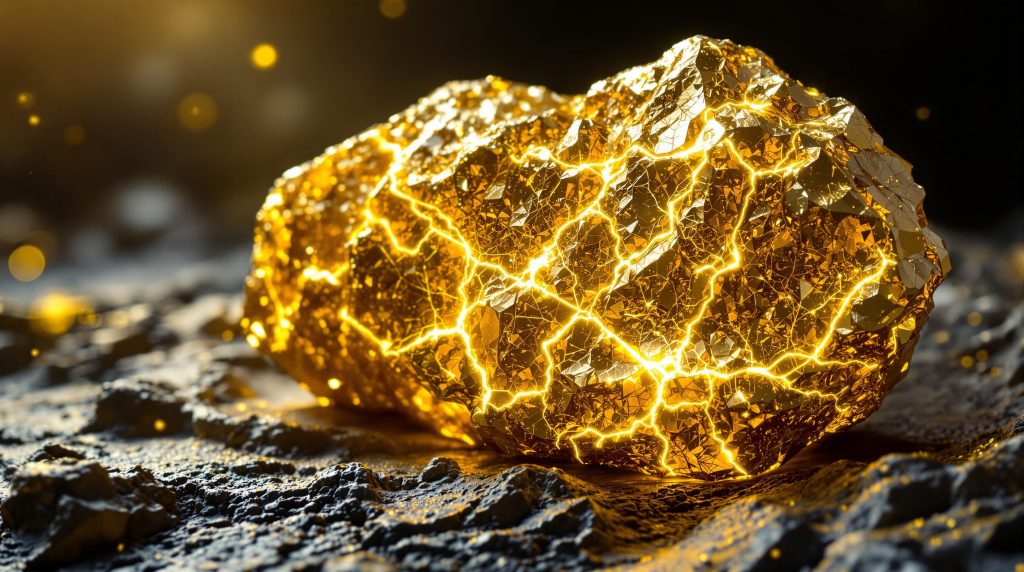How Are Gold Deposits Formed in Earth's Crust?
Gold formation is intimately linked to Earth's dynamic geological processes. These precious metal concentrations result from specific physical and chemical conditions that allow gold atoms—normally dispersed throughout the crust at extremely low concentrations—to accumulate in economically viable deposits.
The Origin of Gold in Earth's Systems
Gold's cosmic origins trace back to neutron star collisions and supernova explosions. These stellar events created the heavy elements that eventually became part of our planet during its formation approximately 4.5 billion years ago. While gold exists throughout Earth's crust, it typically occurs at concentrations of only 0.003-0.004 parts per million (3-4 parts per billion)—far too dispersed for economic extraction without natural concentration processes.
The journey from this dispersed state to concentrated deposits involves complex geochemical processes where gold is leached from source rocks by hydrothermal fluids and subsequently precipitated when physical-chemical conditions change.
Key Geological Mechanisms for Gold Concentration
- Magmatic Differentiation: During magma cooling, gold can become concentrated in specific mineral phases as igneous bodies crystallize
- Hydrothermal Circulation: Hot, metal-rich fluids transport and deposit gold in fracture systems, operating at temperatures between 150°C to 600°C
- Tectonic Activity: Crustal deformation creates pathways for gold-bearing fluids, particularly along major fault zones
- Pressure-Temperature Changes: Variations trigger gold precipitation from solution, especially during rapid cooling events
- Chemical Reactions: Interactions between fluids and host rocks facilitate gold deposition, often involving sulfur compounds
Most significant gold deposits form through fluid-mediated transport and deposition processes operating over geological timescales, requiring specific chemical environments for concentration. Gold's solubility in hydrothermal fluids is primarily controlled by sulfur and chlorine complexes, with sulfur being particularly important at temperatures above 300°C.
What Are the Primary Types of Gold Deposits?
Gold deposits fall into two fundamental categories: primary (bedrock) and secondary (placer) deposits. Each type represents different stages in the geological gold cycle and requires specific exploration and mining approaches.
Primary Hard-Rock Deposits
Primary deposits form when gold is concentrated directly from magmatic or hydrothermal processes within bedrock. These deposits include:
Orogenic Gold Systems
These deposits form along major fault zones in metamorphic belts, typically at depths of 5-15 km beneath the surface. The gold-bearing fluids originate from metamorphic dehydration reactions during mountain-building events. Orogenic gold deposits account for approximately 30% of global gold production and represent the most important class of gold deposits analysis globally.
Key characteristics include:
- Formation along major structural boundaries
- Association with quartz-carbonate veining
- Presence in greenstone belts worldwide
- Connection to compressional tectonic environments
- Examples: Kalgoorlie (Australia), Timmins-Porcupine (Canada)
The Super Pit at Kalgoorlie, Australia, represents a classic orogenic gold system with over 60 million ounces of gold produced throughout its mining history.
Epithermal Deposits
Forming near the surface (typically less than 1.5 km depth) in volcanic environments, epithermal deposits are associated with hydrothermal systems driven by magmatic heat. These deposits show distinct geochemical signatures that reflect their near-surface formation environment and operate at relatively low temperatures between 150-300°C.
They're characterized by:
- Association with volcanic activity
- Distinctive mineral assemblages (adularia, alunite)
- Bonanza-grade potential in vein systems
- Examples: Waihi (New Zealand), Yanacocha (Peru)
Porphyry Gold-Copper Systems
These large-scale deposits form around cooling magmatic intrusions, creating extensive zones of disseminated mineralization. Porphyry systems can contain reserves exceeding 10 million ounces of gold, often with significant copper content.
They feature:
- Massive tonnage but typically lower gold grades
- Significant copper content alongside gold
- Extensive hydrothermal alteration halos
- Formation at intermediate depths (1-5 km)
- Examples: Grasberg (Indonesia), Cadia (Australia)
The Grasberg mine in Indonesia, with reserves exceeding 28 million ounces of gold, demonstrates the exceptional scale of major porphyry deposits.
Carlin-Type Deposits
Named after deposits in Nevada, these distinctive systems feature microscopic gold in altered sedimentary rocks. Carlin-type deposits contain "invisible gold" typically less than 0.1 micrometers in size, hosted primarily in arsenian pyrite.
Key characteristics include:
- "Invisible gold" often bound to pyrite
- Carbonate host rocks with extensive decalcification
- Association with jasperoids and silicification
- Formation along structural controls
- Examples: Carlin Trend (Nevada), Jinying (China)
Secondary Placer Deposits
When primary gold deposits are exposed to weathering and erosion, the liberated gold particles can be transported and concentrated by physical processes, creating secondary deposits:
Alluvial Placers
These form in active or ancient river systems where flowing water concentrates heavy gold particles:
- Gold accumulation in river bends and bedrock traps
- Association with black sand minerals (magnetite, ilmenite)
- Decreasing particle size downstream from source
- Historical importance in gold rushes worldwide
- Examples: Sierra Nevada (California), Klondike (Yukon)
The great gold rushes in California, Australia, and Klondike were primarily driven by rich alluvial placer deposits where gold could be recovered through relatively simple methods.
Eluvial Placers
Occurring near primary deposits, these represent the initial stage of gold weathering and limited transport:
- Formation on hillslopes directly above source deposits
- Angular gold particles with minimal transport
- Association with clay-rich soils and weathered bedrock
- Transitional between primary and alluvial deposits
- Examples: Many small-scale mining operations globally
Beach Placers
Wave action along coastlines can concentrate gold in marine environments:
- Linear concentrations parallel to shorelines
- Association with heavy mineral sands
- Typically fine-grained gold particles
- Examples: Nome (Alaska), West Coast (New Zealand)
Recent discoveries of intrusion-related gold systems (IRGS) in Yukon and Alaska represent an emerging deposit class that bridges the characteristics of both orogenic and porphyry systems, showcasing the continuing evolution of our understanding of gold deposit classification.
How Do Geologists Explore for Gold Deposits?
Modern gold exploration combines traditional field methods with advanced technologies to identify potential deposits with increasing precision. This systematic process moves from regional reconnaissance to targeted drilling, with success rates averaging only 1 in 3,000 to 1 in 5,000 prospects leading to economic deposits.
Geological Mapping and Structural Analysis
The foundation of gold exploration begins with understanding regional and local geology:
- Identification of favorable host rocks and structures
- Mapping of alteration patterns and mineralized zones
- Recognition of regional metallogenic belts
- Documentation of historical mining activities
- Analysis of structural controls on mineralization
Successful gold exploration requires integration of geological, geochemical, and geophysical datasets within a comprehensive geological framework that considers both regional context and local variations.
Geochemical Exploration Techniques
Chemical analysis of various sample media helps detect subtle gold anomalies, with modern analytical techniques capable of detecting gold at concentrations as low as 1 part per billion:
Soil Sampling Programs
- Systematic collection across grid patterns
- Analysis for gold and pathfinder elements
- Identification of dispersion patterns
- Integration with geological mapping
- Detection limits as low as parts per billion
Pathfinder elements such as arsenic, antimony, and mercury often provide stronger anomalies than gold itself in regional exploration, creating larger target footprints for follow-up investigation.
Stream Sediment Surveys
- Sampling of active drainage systems
- Concentration of heavy minerals for analysis
- Coverage of large areas efficiently
- Tracing anomalies upstream to source
- Complementary panning for visible gold
Rock Sampling and Analysis
- Channel sampling of outcrops and exposures
- Chip sampling across mineralized zones
- Whole-rock geochemistry for alteration patterns
- Multi-element analysis for deposit signatures
- Petrographic studies of mineralized samples
Portable X-ray fluorescence (pXRF) analyzers now provide real-time analysis with detection limits of 1-5 ppm for pathfinder elements, revolutionizing field-based geochemical exploration.
Geophysical Exploration Methods
Since gold itself lacks distinctive geophysical properties, indirect methods target associated features:
- Magnetic Surveys: Identify magnetite destruction zones associated with hydrothermal alteration
- Induced Polarization: Detect disseminated sulfides often associated with gold, with penetration depths exceeding 200 meters
- Electromagnetic Methods: Map conductive zones related to structural controls
- Gravity Surveys: Identify density contrasts in potential host rocks
- Radiometric Surveys: Detect potassic alteration patterns
The discovery of the Fosterville gold mine in Australia utilized integrated geophysical and geochemical techniques to identify high-grade zones beneath previous workings, showcasing the power of combined exploration methodologies.
Advanced Drilling and Sampling
Once target areas are identified, direct sampling through drilling becomes essential:
- Diamond Drilling: Recovers continuous core samples for detailed analysis
- Reverse Circulation Drilling: Provides chip samples for rapid assessment
- Rotary Air Blast Drilling: Enables cost-effective preliminary testing
- Trenching and Pitting: Exposes bedrock in areas of shallow cover
- Bulk Sampling: Collects larger volumes for metallurgical testing
3D modeling and resource estimation typically require drill hole spacing of 25-50 meters for indicated resources, with closer spacing needed for measured resource categories.
3D Modeling and Resource Estimation
Modern exploration culminates in digital modeling to visualize deposits:
- Integration of all datasets into comprehensive 3D geological modelling models
- Statistical analysis of grade distribution
- Geostatistical techniques for resource estimation
- Block modeling for mine planning
- Risk assessment and economic evaluation
Artificial intelligence and machine learning are revolutionizing mineral exploration by identifying subtle patterns in complex geological datasets that might be missed by traditional analysis methods.
What Makes Gold Deposits Economically Significant?
The economic importance of gold deposits extends beyond the intrinsic value of the metal itself, impacting global financial systems, technological innovation, and regional development.
Global Financial Significance
Gold maintains a unique position in the global economy:
- Monetary Reserve Asset: Central banks held approximately 36,000 tonnes of gold reserves as of 2023
- Investment Hedge: Protection against inflation and currency fluctuations
- Market Benchmark: Gold price serves as an economic indicator
- Trading Volume: Daily gold trading exceeds $150 billion globally
- ETF Holdings: Investment vehicles hold thousands of tonnes in physical gold
Gold serves as a portfolio diversifier and hedge against inflation, maintaining its relevance in modern financial systems despite the evolution of digital currencies and alternative investments.
Industrial and Technological Applications
Beyond its monetary role, gold serves critical functions in modern technology:
Electronics and Computing
- Corrosion-resistant connectors and contacts
- Bonding wires in semiconductor packages
- Conductive layers in circuit boards
- Memory chips and switching devices
- Electromagnetic shielding
Gold's electrical conductivity (45.2 MS/m) and corrosion resistance make it essential for high-reliability electronic connections in critical applications.
Medical and Healthcare
- Biocompatible dental restorations
- Diagnostic tools and equipment
- Radiotherapy applications
- Anti-inflammatory treatments for rheumatoid arthritis
- Medical implant coatings
Aerospace and Advanced Engineering
- Radiation shielding in spacecraft
- Thermal protection systems
- Precision instruments and sensors
- Satellite components
- High-reliability electrical contacts
The electronics industry alone consumes approximately 280 tonnes of gold annually, representing 8% of total demand, with applications continuing to expand as technology advances.
Regional Economic Development
Gold mining operations create significant economic impacts:
- Employment Generation: Direct and indirect job creation
- Infrastructure Development: Roads, power, and water systems
- Tax Revenue: Royalties and corporate taxes
- Skills Development: Technical training and knowledge transfer
- Supply Chain Benefits: Local business opportunities
Global gold production reached approximately 3,000 tonnes in 2023, valued at over $200 billion USD, making it one of the world's most valuable mineral commodities and a cornerstone of many national economies.
How Do Environmental Considerations Impact Gold Mining?
The environmental footprint of gold mining presents significant challenges that the industry continues to address through technological innovation and improved practices.
Environmental Challenges in Gold Extraction
Gold mining can create substantial environmental impacts:
Land Disturbance and Habitat Effects
- Open-pit mining creates large surface disturbances
- Underground operations may cause subsidence
- Tailings storage facilities require significant land area
- Access infrastructure fragments natural habitats
- Post-mining landscape transformation
Approximately 20 tonnes of waste rock are generated per ounce of gold extracted in typical operations, creating significant waste management challenges.
Water Management Issues
- Acid mine drainage from sulfide-bearing waste
- Process water containing dissolved metals
- Sediment loading in downstream waterways
- Groundwater drawdown from dewatering
- Competition with other water users
Acid mine drainage occurs when sulfide minerals in waste rock oxidize, producing sulfuric acid with pH levels as low as 2-3, which can persist for decades if not properly managed.
Chemical Use Concerns
- Cyanide leaching for gold recovery
- Mercury use in artisanal mining
- Reagents for mineral processing
- Acid consumption in refractory ore treatment
- Chemical transportation and storage risks
Cyanide consumption in gold processing averages 0.5-2 kg per tonne of ore processed, requiring strict management protocols to prevent environmental contamination.
Sustainable Mining Practices
The gold mining industry has developed various approaches to minimize environmental impacts:
- Mine Rehabilitation: Progressive reclamation and ecosystem restoration
- Water Recycling: Closed-loop systems to minimize freshwater consumption
- Energy Efficiency: Renewable power integration and efficiency improvements
- Cyanide Management: Implementation of International Cyanide Management Code
- Biodiversity Programs: Offset initiatives and habitat conservation
Modern cyanide detoxification processes can achieve residual concentrations below 10 ppm in tailings, significantly reducing environmental risks compared to historical practices.
Recycling and Urban Mining
Recovering gold from existing products reduces the need for new mining:
- Electronics Recycling: Recovery from e-waste streams
- Jewelry Reprocessing: Refining of used gold items
- Industrial Scrap: Collection of manufacturing waste
- Urban Mining: Targeting gold-rich waste streams
- Closed-Loop Systems: Manufacturer take-back programs
The Yanacocha mine in Peru implemented successful water management systems reducing freshwater consumption by 40%, demonstrating the potential for improved environmental performance in large-scale operations.
What Are the Global Distribution Patterns of Gold Deposits?
Gold deposits show distinctive global distribution patterns related to geological history and tectonic settings.
Major Gold-Producing Regions
Gold production is concentrated in specific geological provinces:
Archean Greenstone Belts
- Witwatersrand Basin, South Africa
- Yilgarn Craton, Western Australia
- Superior Province, Canada
- Zimbabwe Craton, Southern Africa
- Pilbara Craton, Australia
The Witwatersrand Basin has produced over 1.5 billion ounces of gold since discovery, representing approximately one-third of all gold ever mined in human history.
Phanerozoic Orogenic Belts
- Tien Shan, Central Asia
- Lachlan Fold Belt, Australia
- Appalachian Mountains, North America
- Andean Cordillera, South America
- European Variscides
Archean greenstone belts, formed 2.5-3.8 billion years ago, contain the highest concentration of large gold deposits globally, highlighting the importance of ancient crustal processes in gold endowment.
Circum-Pacific "Ring of Fire"
- Nevada Gold Trends, USA
- Maricunga Belt, Chile
- Grasberg-Ertsberg District, Indonesia
- Lihir Island, Papua New Guinea
- Hishikari, Japan
The Superior Province in Canada contains over 200 gold deposits with combined production exceeding 180 million ounces, making it one of the world's premier gold-producing regions.
Historical Evolution of Gold Mining
Gold production has shifted geographically throughout history:
- Ancient civilizations: Egypt, Nubia, Roman provinces
- Medieval period: West Africa, Central Europe
- Colonial era: Spanish America, Brazil
- 19th century: California, Australia, South Africa
- 20th century: North America, former Soviet Union, Australia
- 21st century: China, West Africa, South America
China leads global gold production with approximately 330 tonnes annually, followed by Australia (320 tonnes) and Russia (300 tonnes), with approximately 70% of global gold reserves occurring in just 10 countries.
Future Gold Frontiers
Exploration continues to target new regions and deposit types:
- Deep extensions of known deposits
- Under-explored regions in Africa and Asia
- Seafloor massive sulfide deposits
- Refractory ore bodies with improving technology
- Reprocessing of historical mine waste
Emerging gold provinces in West Africa and Central Asia represent some of the most promising regions for new discoveries, with significant exploration investment targeting these frontier areas.
What Recent Advances Are Changing Gold Exploration and Mining?
Technological innovation continues to transform how gold deposits are discovered, evaluated, and developed.
Modern Exploration Technologies
New tools are enhancing exploration efficiency:
- Hyperspectral Imaging: Remote detection of alteration minerals at wavelengths between 400-2500 nanometers with 1-meter spatial resolution
- Portable XRF Analyzers: Rapid field geochemistry with real-time results
- Drone-Based Surveys: High-resolution mapping of inaccessible areas
- Machine Learning Algorithms: Pattern recognition in complex datasets, processing information 1000x faster than traditional methods
- Biogeochemical Sampling: Plant tissue analysis for deep-seated deposits
Artificial intelligence and machine learning are revolutionizing mineral exploration by identifying subtle patterns in complex geological datasets that might be missed by traditional analysis methods.
Innovations in Mining and Processing
Extraction and recovery technologies continue to evolve:
- Autonomous Mining Equipment: Remote-operated machinery operating 24/7 with 15-20% higher productivity
- In-Situ Recovery: Minimally invasive extraction methods reducing surface disturbance by up to 90%
- Ore Sorting Technology: Pre-concentration to reduce processing volumes
- Biological Leaching: Microbial extraction of gold from complex ores
- Reagent-Free Processing: Physical separation methods reducing chemical use
Rio Tinto's autonomous haul truck fleet demonstrates the potential for unmanned mining operations, improving both safety and efficiency while reducing operating costs.
Digital Transformation in the Gold Sector
Data integration and analysis are revolutionizing the industry:
- Real-Time Monitoring: Continuous measurement of operational parameters
- Predictive Maintenance: Reducing equipment downtime
- Digital Twins: Virtual replicas of physical operations
- Blockchain Traceability: Supply chain transparency for gold provenance
- Integrated Operations Centers: Centralized decision-making hubs
Blockchain technology provides immutable records of gold provenance from mine to market, addressing increasing consumer and investor demand for responsibly sourced materials.
FAQs About Gold Deposit Formation
How long does it take for a gold deposit to form?
Gold deposit formation varies dramatically depending on the deposit type. Hydrothermal systems may operate for thousands to millions of years, while the concentration of placer deposits can occur over much shorter geological timeframes. The complete cycle from initial gold concentration to economically viable deposit typically spans millions of years.
Why is gold often found with quartz?
Quartz and gold commonly occur together because both precipitate from similar hydrothermal fluids. As these hot, mineral-rich solutions move through fractures in the Earth's crust, changing conditions cause both silica (forming quartz) and gold to precipitate. Quartz is also chemically stable and resistant to weathering, preserving the associated gold through geological time.
Can gold deposits form today?
Yes, gold deposits are actively forming in modern geological environments. Active geothermal systems, such as those in New Zealand and Iceland, demonstrate ongoing gold deposition. Additionally, modern rivers continue to concentrate placer gold deposits from eroding primary sources. However, these processes operate over geological timescales, making human observation of complete deposit formation impossible.
What is the difference between lode gold and placer gold?
Lode (or primary) gold refers to gold still contained within its original host rock, typically in veins or disseminated throughout the rock mass. Placer (or secondary) gold has been liberated from its source rock through weathering and transported by water, gravity, or glacial action before being redeposited in streams, rivers, or beach environments. Placer gold typically shows signs of transport such as rounding and flattening.
How do geologists determine the age of gold deposits?
Dating gold deposits involves several techniques:
- Dating associated minerals (like pyrite or muscovite) using radiometric methods
- Determining the age of host rocks and cross-cutting relationships
- Analyzing the relationship to dated geological events
- Examining regional metamorphic and deformation histories
- Applying geochronological techniques to alteration minerals
Conclusion: The Continuing Significance of Gold Deposit Research
Understanding the geological formation of gold deposits remains crucial for both scientific and practical reasons. As accessible deposits become scarcer, exploration increasingly targets deeper, lower-grade, or more complex ore bodies, requiring sophisticated geological models. Meanwhile, the environmental and social contexts of gold mining continue to evolve, demanding more sustainable approaches to extraction and processing.
The study of gold deposits provides valuable insights into Earth's geological processes, from deep crustal dynamics to surface weathering systems. These natural concentration mechanisms not only create economically important resources but also offer windows into the planet's complex geological history.
As technology advances and our understanding deepens, gold deposit research continues to bridge fundamental geological science with practical applications in exploration, mining, and environmental management—ensuring that this precious metal remains accessible while minimizing the impacts of its extraction.
Gold mining generates approximately 3.3 tonnes of CO2 equivalent per ounce of gold produced, highlighting the industry's significant carbon footprint and the importance of transitioning toward more sustainable practices through technological innovation and improved environmental standards.
The convergence of artificial intelligence, automation, and improved recovery methods points toward a future where gold-copper exploration becomes more precise, less environmentally impactful, and increasingly efficient—continuing the evolution of an industry that has shaped human civilization for thousands of years.
Further Exploration:
Readers interested in learning more about the geological formation of gold deposits can also explore related educational content on the USGS website, which provides comprehensive information about gold prospecting and drilling interpretation methods, as well as a detailed mineral deposit guide for those new to the field.
Want to Capitalise on the Next Major Gold Discovery?
Discovery Alert's proprietary Discovery IQ model instantly notifies investors of significant ASX gold discoveries, turning complex geological data into actionable investment insights. Discover why major mineral discoveries can generate substantial returns by visiting Discovery Alert's dedicated discoveries page and position yourself ahead of the market with a 30-day free trial.




